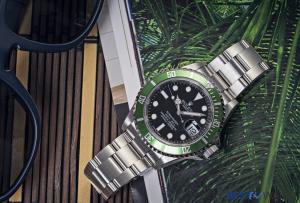
Introduction
The Rolex Explorer family has been known for extremely robust, accurate and exceptionally reliable professional timepieces. The brand offers two distinct ranges from this well-established wristwatch family: Explorer I & Explorer II.
The Explorer line belongs to the iconic Swiss brand’s Professional Range, which also includes Submariner, Cosmograph Daytona, Sea-Dweller, GMT-Master II, Yacht-Master, Milgauss and Air-King watch collections. Each timepiece from the Rolex Professional family has been exclusively designed for various environments in the land, air or sea. Among them, the rolex explorer watches are ideally suitable for both amateur adventurers and professionals, involved in mountaineering, polar expeditions and other outdoor activities.
The Explorer II is an evolution of the iconic Rolex Explorer I watch introduced in 1953. The inaugural model of the Explorer II was unveiled in 1971. With their fixed 24-hour bezel, the additional hour-hand and instantaneous date function, the Explorer II watches stand out within the Explorer line. Since its induction, the Explorer II has been evolved into four references: 1655 (1971 to 1984), 16550 (1984 to 1989), 16750 (1989 to 2011) and 216750 (from 2011). As on date, Rolex produces Explorer II watches under the reference 216750.
The Explorer family is the most accessible within the Rolex Professional watch range.
History of Rolex Explorer II
In 1926, Rolex introduced Oyster, a water-proof and dust-proof wristwatch. The name ‘Oyster’ refers to the hermetically sealed case of this timepiece. Since then, Rolex has been manufacturing precise and robust timekeepers especially designed for both amateur and professional explorers. In 1953, the Explorer collection was introduced. These timepieces featured exceptionally water-resistant oyster steel cases and highly reliable self-winding movements. Presently comes under the Professional Collection, the Explorer models are the descendants of the original Oyster watch.
On 29th May 1953, Tenzing Norgay and Edmund Hillary reached the peak of the Mount Everest, the highest mountain in the world. They were the members of a Himalayan mission led by British Army Colonel John Hunt. Rolex, which had been supplying timepieces to mountain expedition teams since the 1930s, provided their Perpetual Oyster watches to the 1953 expedition members. Equipped with robust stainless steel case, highly readable dial and precise self-winding movement, these timepieces were capable to withstand extreme sub-zero temperatures.

Launched in the same year of the first conquest of the Mount Everest, Rolex Explorer 1 celebrates one of the most extraordinary achievements in the world history. The initial model was reference 6350. In 1954, Rolex introduced reference 6150. The next evolution was Ref. 6610, which was succeeded by the reference 1016 in 1963. Rolex introduced the reference 14270 in 1989. The most recent addition is the rolex explorer 2016 model with reference number 214270. The Rolex Explorer price is approximately HK$ 80,000 each for the new reference. Highly sought after, the historical explorer models are expensive than the new generation references.

Typically featuring the time-only layout with three centre hands, Explorer is an ultimate tool watch for adventurous activities like mountaineering. The Rolex Explorer I model does not feature any additional hand, graduated bezel or date. These standard specifications remain same even in new generation models.
Just like mountaineering, both Speleology and Spelunking are conducted under hostile environments. Speleology refers to the scientific study of the caves and Spelunking (also called caving or potholing) is the leisure activity of exploring wild cave systems. In some occasions, explorers have to stay prolonged durations inside the caves. Along with the safety equipment and clothing, a reliable timepiece with luminescent display is a must for cave explorers.
For both amateur and professional cave explorers, it was necessary to have some sort of indication on their wristwatches to differentiate between AM and PM. So Rolex developed the Explorer II, a professional timepiece capable of displaying both night-hours and day-hours simultaneously.
The Evolution of Rolex Explorer II

The first reference from the rolex explorer 2 series was Ref.1655. The stand-out features that differentiate this 39mm stainless steel watch were: the fixed 24-hour graduated bezel, the arrow-shaped additional hand and the date window at 3H. Equipped with the 1575 movement, the reference 1655 was made available in black dial with lumed indices and hands (MK I, II& III dial versions with Tritium and MK IV dial versions with Luminova). The large, orange-colored 24-hour hand is a key attraction of this reference. Coupled with the main time mechanism, this hand allowed the wearer to set the timepiece for displaying 24 hour format to distinguish night-hours from day-hours. This enhanced function made the Explorer II a perfect timekeeper for speleologists, spelunkers and miners. Rolex ceased the production of Ref.1655 in 1984.
The company commenced the production of the new Explorer II reference 16550 in 1985. An evolution of reference 1655, this version features stainless steel case measuring 40mm diameter, 1mm larger than its predecessor. To equip this model, Rolex opted caliber 3085, the same self-winding movement used in the Rolex GMT Master II 16760 aka “Fat Lady.”
Available in black or white dial versions, the reference 16550 features the hour-hand in so-called ‘Mercedes’ style, minute hand, central seconds hand and a slender 24-hour hand in red color and triangle pointer. The design of hour-markers also changed. For example, from this new reference Rolex began using circle hour-markers for 1, 2,4,5,7,8,10 and 11, where as the Ref.1655 features rectangular indices for the same. The triangle maker at 12H, the large rectangular hour-markers at 6H and 9H, and the date display at 3H remain unchanged in all Explorer II watch models.
The functional improvement introduced in this reference was the independently adjustable 24-hour hand. It enabled simultaneous reading of the time in two time-zones, like a GMT watch. However, the 24-hour fixed bezel design remains unchanged. Rolex ceased the production of reference 16550 in 1989.

The subsequent evolution in the Explorer II family is the reference 16570. Introduced in 1989, Rolex continued the production of this model until 2011, making it one of the longest produced series in the history of the Swiss watch giant. This reference retained most of the features of its previous model, like the 40mm diameter oyster case, jumping local hour hand, black and white dials, the slim 24-h hand in red color, and the fixed bezel. In this new version, Rolex used updated movements. The Rolex Explorer II 16570 models produced from 1989 to 2005 are equipped with caliber 3185 while the models from 2005 to 2011 house the caliber 3186. These self-winding movements were made in-house and rated for 50 hours power reserve.
All Explorer II models manufactured until 1998 had tritium lumes and those made from 1998 to 1999 had Luminova. In 1999, Rolex replaced Luminova with Super-Luminova. So the explorers produced between 1999 and 2011 have the Super-Luminova luminescent coating on their hands and indices.

In 2011, on the 40th anniversary of the collection, Rolex launched a large version of the Explorer II watch. Featuring a 42mm diameter Oyster case, the reference is 216570 brought in some design changes and functional improvements. The so-called Super case (maxi case) in stainless steel has chunky crown guards and wide lugs. Rolex also enhanced the size of hour-markers and the hands. To fit with the 42mm case, Rolex developed a new automatic dual-time movement, the Caliber 3187. Available in black or white dial, this reference also marked the return of the large, orange-colored 24 hour hand. Another key design enhancement was the introduction of the brand’s proprietary lume Chromalight, which emits an attractive blue radiance in comparison with the green glow of Super-Luminova.
The Rolex Explorer II price vary depends upon the reference and the year of production. It costs about HK $100,000 each for the latest Explorer II 216570 watch. Older production models of the same reference (for example: Rolex Explorer ii 2017) might be available in lesser prices.
Conclusion
Before wrapping up, let us go through some interesting facts about the Rolex Explorer II watch series.
- All Explorer II watch models are traditionally made of oyster steel, and are water resistant to 100 meters. Three case diameters have been used since the induction: 39mm (for reference 1655), 40mm (for references 16550 and 16570) and 42mm (for reference 216570).
- In comparison with the rotatable bezels of GMT Master II and Submariner models, the Explorer II watches feature a fixed 24-hour graduated-bezel in stainless steel. It remained the stand-out feature of all Explorer II models produced since its induction. The bezel of the first reference (Ref.1655) feature lines for odd numbers and digits for even numbers. In all other references, triangle shape markers have been used for odd numbers and digits for even numbers.
- All Explorer II watches feature an extra hour-hand in addition to the hour, minute and second hands. In the first reference (Ref.1655), this hand has been used solely for distinguishing night-hours from day-hours along with the graduated 24-hour bezel. In the subsequent references (16550, 16570 and 216570), the wearer could also track a second time-zone with the 24-hour hand. Due to this add-on function, all modern Explorer II references can be used as a great traveler’s watch. The references 1655 and 216570 have a large, orange color 24-hour hand where as a slim, red hand has been used in 16550 and 16570 versions.
- All Explorer II watch models house extremely precise self-winding movements with perpetual rotors. The calibers are: Cal.1575 in reference 1655, Cal. 3085 in reference 16550, Cal. 3185 or 3186 in reference 16570, and Cal. 3187 in reference 216570. All of them are superlative chronometer movements and have instantaneous date function at 3 o’ clock.
- The Explorer II series offers limited dial colors only. The reference 1655 was made with black dial only and all the other three references offer black and white versions. As on date, there are no other dial colors available other than black and white.
- The nickname given by enthusiastic collectors for the reference 1655 is Freccione, which is the Italian word for ‘Orange hand.’ The “Polar Explorer” is the nickname of Rolex Explorer II reference 16570 with a white dial.
- The reference 16550 models had some dial painting defects. Due to this, the color of white dials gradually changed into cream after some years and the black dials began developing cracks. Interestingly, these imperfections made the particular Explorer II reference, a highly sought-after collector’s model.



Leave A Reply
Your email address will not be published.
Thank you for your comments
We have received your comment and it is being processed.Oops, Something Went Wrong
Please try again later.